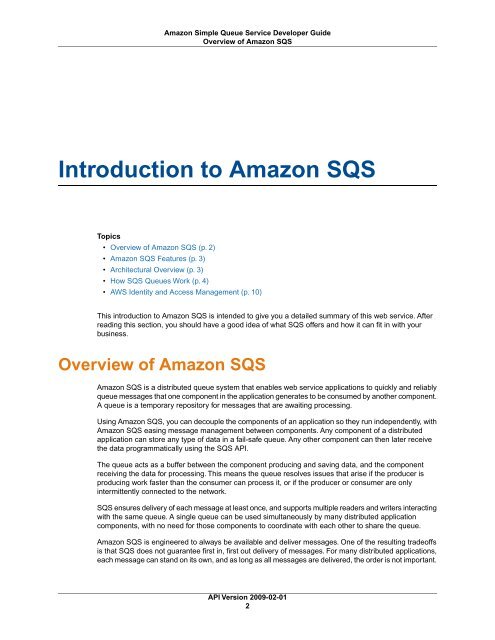You also want an ePaper? Increase the reach of your titles
YUMPU automatically turns print PDFs into web optimized ePapers that Google loves.
Amazon Simple Queue Service Developer Guide<br />
Overview of Amazon SQS<br />
Introduction to Amazon SQS<br />
Topics<br />
• Overview of Amazon SQS (p. 2)<br />
• Amazon SQS Features (p. 3)<br />
• Architectural Overview (p. 3)<br />
• How SQS Queues Work (p. 4)<br />
• AWS Identity and Access Management (p. 10)<br />
This introduction to Amazon SQS is intended to give you a detailed summary of this web service. After<br />
reading this section, you should have a good idea of what SQS offers and how it can fit in with your<br />
business.<br />
Overview of Amazon SQS<br />
Amazon SQS is a distributed queue system that enables web service applications to quickly and reliably<br />
queue messages that one component in the application generates to be consumed by another component.<br />
A queue is a temporary repository for messages that are awaiting processing.<br />
Using Amazon SQS, you can decouple the components of an application so they run independently, with<br />
Amazon SQS easing message management between components. Any component of a distributed<br />
application can store any type of data in a fail-safe queue. Any other component can then later receive<br />
the data programmatically using the SQS API.<br />
The queue acts as a buffer between the component producing and saving data, and the component<br />
receiving the data for processing. This means the queue resolves issues that arise if the producer is<br />
producing work faster than the consumer can process it, or if the producer or consumer are only<br />
intermittently connected to the network.<br />
SQS ensures delivery of each message at least once, and supports multiple readers and writers interacting<br />
with the same queue. A single queue can be used simultaneously by many distributed application<br />
components, with no need for those components to coordinate with each other to share the queue.<br />
Amazon SQS is engineered to always be available and deliver messages. One of the resulting tradeoffs<br />
is that SQS does not guarantee first in, first out delivery of messages. For many distributed applications,<br />
each message can stand on its own, and as long as all messages are delivered, the order is not important.<br />
API Version <strong>2009</strong>-<strong>02</strong>-<strong>01</strong><br />
2

















